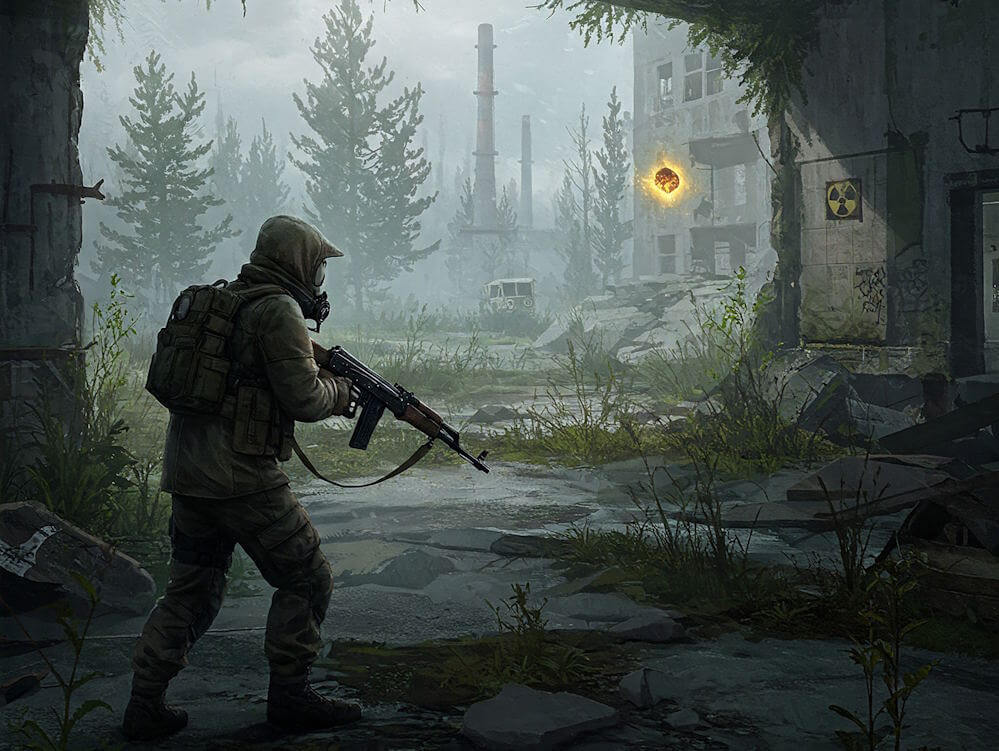‘Stalker 2’ represents a highly anticipated continuation of the acclaimed Stalker video game series, which has captivated gamers since its inception. Developed by GSC Game World, this sequel is set to expand the franchise’s unique blend of survival horror and immersive storytelling. The game’s setting, taking place within the infamous Chernobyl Exclusion Zone, offers a rich backdrop filled with atmospheric environments and an undercurrent of dread that fans have come to appreciate. This location not only enhances gameplay but also deepens the thematic exploration of survival in a world shaped by disaster.
The significance of ‘Stalker 2’ stems from both its heritage and its innovative approach to the gaming landscape. As a sequel, it carries the weight of expectations from a dedicated fanbase that has been eagerly awaiting its release since the announcement. The studio’s commitment to staying true to the original while introducing fresh elements demonstrates a keen understanding of the series’s essence. The anticipation surrounding the game is palpable, with players intrigued by the possibilities of new advanced mechanics, expansive open-world exploration, and a gripping narrative.
Furthermore, ‘Stalker 2′ tunnels into the deeper themes of horror and post-apocalyptic survival, raising existential questions about humanity amidst the remnants of catastrophe. These themes resonate strongly with players, making them emotionally invested in their characters’ journeys. With a combination of tense gameplay, an immersive world, and intricate storytelling, ‘Stalker 2’ promises to deliver a chilling experience that draws players into its harsh, beautiful, and dangerous landscapes. The journey toward its release continues to excite and entice, setting the stage for one of the most talked-about titles in the gaming community.
The Legacy of the Stalker Series
The Stalker series, which has carved a unique niche within the gaming industry since its inception, began with the release of the critically acclaimed title “S.T.A.L.K.E.R.: Shadow of Chernobyl” in 2007. Developed by GSC Game World, this first installment brought players into the harrowing landscape of the Chernobyl Exclusion Zone, where they encountered atmospheric storytelling combined with immersive gameplay mechanics. The game’s innovative blend of first-person shooter elements, role-playing games (RPG)-like features, and a persistent open world signaled a transformative moment in gaming, garnering a dedicated fan base.
Following Shadow of Chernobyl, GSC Game World released “S.T.A.L.K.E.R.: Clear Sky” in 2008. This prequel provided deeper narrative context and expanded upon the mechanics of its predecessor. Although it received mixed reviews compared to the original, it introduced new factions, enhanced artificial intelligence, and a dynamic weather system, which enriched the overall gameplay experience. Such innovations reflected the developers’ commitment to evolving the series while remaining true to its roots.
The culmination of the original trilogy was “S.T.A.L.K.E.R.: Call of Pripyat,” released in 2009. This entry, often hailed as the pinnacle of the series, built upon the solid foundations laid by its predecessors, successfully refining various gameplay aspects. Players were treated to a more polished experience, featuring improved graphics, an engaging storyline, and an expanded game world, which further captivated the audience’s imagination. The positive critical reception of Call of Pripyat solidified the series’ reputation, recognizing it as a pioneering force in the survival horror genre and a benchmark for open-world narratives.
Overall, the legacy of the Stalker series is marked by its innovative gameplay, immersive environments, and compelling storytelling, which have collectively influenced the development of future games. As fans eagerly anticipate the release of Stalker 2, the history of this franchise raises expectations for groundbreaking advancements and continued exploration of themes rooted in survival within a post-apocalyptic landscape.
Behind the Scenes: Development of Stalker 2
The development of Stalker 2 is a noteworthy journey, steeped in the ambition of GSC Game World, a studio renowned for its innovative approach to game design. Established in 1995, GSC Game World gained prominence for its rich storytelling and immersive gameplay in the original Stalker series. As the development team embarked on the creation of Stalker 2, they encountered a series of challenges that tested their creativity, resilience, and commitment to quality.
One of the key hurdles was the technological shift that occurred during the production timeline. Originally announced in 2010, Stalker 2 faced multiple interruptions, including the dissolution of GSC Game World. This setback led to uncertainty, with many fearing that the game would never materialize. However, in 2018, the studio was revived and production resumed, marking a new chapter for the franchise. The team aimed to leverage advancements in graphics and gameplay mechanics, utilizing the Unreal Engine 4 to create a compelling and visually stunning experience that could resonate with both new and returning players.
Furthermore, the development process for Stalker 2 has been heavily influenced by player feedback from the previous installments. GSC Game World actively engaged with its fanbase through various platforms, taking note of their expectations and critiques. This interaction not only fostered a sense of community but also provided valuable insights that were incorporated into the game’s design, ensuring that it retained the core essence of the Stalker universe while embracing innovation.
Ultimately, the path to creating Stalker 2 exemplifies the complexities and triumphs of modern game development. While navigating technological advancements and fluctuating industry dynamics, GSC Game World remains dedicated to delivering a game that pays homage to its legacy while pushing the boundaries of interactive storytelling.
Gameplay Mechanics and Features
Stalker 2, the much-anticipated sequel in the renowned series, brings an array of gameplay mechanics and features aimed at enriching the player’s experience in the hauntingly immersive world of the Zone. As players traverse this post-apocalyptic landscape, they will encounter a dynamic environment filled with unpredictability, necessitating adaptive strategies for survival. The game will utilize advanced graphics and physics engines that enhance realism, allowing players to experience changing weather conditions, day-night cycles, and environmental hazards that significantly impact gameplay.
One of the standout features of Stalker 2 is its character progression system, which allows players to fine-tune their abilities and skills. Unlike its predecessors, this installment introduces an RPG-like development framework where players can earn experience points through various activities, shaping their character’s strengths and weaknesses. This progression system promotes a more personalized approach to gameplay, enabling each player to tailor their character’s skill set according to their preferred playstyle, be it stealth, combat, or exploration.
Interaction with non-player characters (NPCs) will also undergo significant improvements. Stalker 2 promises a richer narrative experience through enhanced dialogue systems and branching storylines, where players’ choices directly influence the outcomes of quests and character relationships. This level of engagement with NPCs not only enriches the storyline but also creates a more immersive, living world that reacts to player decisions.
Furthermore, the introduction of new gameplay dynamics, such as faction warfare and cooperative multiplayer options, signals a departure from the linearity of previous titles. Players can now engage in large-scale conflicts between various factions vying for control over the Zone, adding strategic layers to the gameplay. In this way, Stalker 2 elevates the experience with a combination of familiar and innovative elements, seamlessly blending adventure and strategy while honoring the legacy of the series.
The World of Chernobyl: A Closer Look
The setting of Stalker 2, the Chernobyl Exclusion Zone, serves as both a backdrop and a character in its own right, embodying the haunting remnants of nuclear catastrophe. The game meticulously recreates this environment, drawing upon the historical context of the Chernobyl disaster in 1986, which resulted in the evacuation and abandonment of the surrounding areas. This desolation has been artistically interpreted to immerse players in a landscape that resonates with real-world tensions, where nature reclaims what humanity has forsaken.
The Chernobyl Exclusion Zone is distinguished by its eerie silence, punctuated only by the unsettling sense of danger that comes from enduring radiation and the presence of mutant creatures. Developers have invested considerable effort in accurately representing key locations such as Pripyat, the ghost town adjacent to the nuclear power plant. This attention to detail not only enhances the authenticity of gameplay but also serves to create an unsettling atmosphere. Players navigate through crumbling edifices and dilapidated structures, with the radiation levels serving as both a gameplay mechanic and a symbolic reminder of the past’s dire consequences.
The impact of radiation extends beyond just a gameplay challenge; it fosters a sense of vulnerability and tension, ensuring that players remain acutely aware of their surroundings and the perilous environment. The stark contrast between the tranquil natural beauty of the landscape and the haunting reminders of a human-made disaster accentuates the theme of survival in a world that is both alive and dangerous. By integrating the complexities of the Chernobyl Exclusion Zone into its world design, Stalker 2 successfully creates an immersive experience that challenges players to confront the ghosts of history while navigating the treacherous terrain.
Anticipating the Hype: Community Reactions and Expectations
The anticipation surrounding the release of Stalker 2 has ignited considerable buzz within the gaming community. Fans of the series are expressing their enthusiasm through various platforms, such as social media channels and gaming forums, creating a vibrant dialogue around the upcoming title. This excitement reflects a shared expectation for a game that not only adheres to the series’ legacy but also introduces innovative features that elevate the gameplay experience.
One of the primary sources of anticipation stems from the promise of an expansive open world, enabling players to traverse the iconic Chernobyl Exclusion Zone with greater freedom and realism than ever before. The prospect of an immersive atmosphere, complemented by cutting-edge graphics and audio, has generated numerous discussions on platforms like Reddit and Twitter. Many users are especially keen on how the game will leverage next-generation technology to enhance the storytelling and environmental interactions integral to the Stalker series.
Furthermore, the community is particularly excited about the announced multiplayer component, which signifies a departure from the largely single-player focus of previous installments. Gamers are speculating on how cooperative gameplay mechanics could be implemented, potentially allowing players to band together to navigate the hazardous environments filled with anomalies and mutants. This evolution in gameplay has led to a flurry of theories and hopes regarding team dynamics and shared missions.
Additionally, specific features such as dynamic weather systems and the integration of player-driven narratives have captured the imagination of the community. As players engage in discussions about what they wish to see enhanced or retained from prior games, it becomes evident that the expectations for Stalker 2 are not merely about nostalgia but a desire for a profound and enriching gaming experience that embraces both classic elements and modern innovations. Such anticipation continues to build as the release date approaches, fueling a collective hope for a remarkable return to the Stalker universe.
The Role of Storytelling in Stalker 2
Storytelling plays a critical role in the immersive experience of Stalker 2, intricately weaving narrative elements with gameplay mechanics to create a unique atmosphere that resonates deeply with players. The game’s plot unfolds within the infamous Chernobyl Exclusion Zone, a setting that is not only historically rich but carries an inherent sense of danger and mystery. This environment allows the game to explore universal themes of humanity, desperation, and resilience, making it considerably more than just a survival horror experience.
The narrative of Stalker 2 encapsulates the struggles of individuals caught in an environment where the laws of nature and morality are constantly challenged. The protagonists face not only physical threats from the mutated inhabitants of the zone but also existential dilemmas that force them to confront their own humanity. By integrating these storytelling elements, the game invites players to delve into the moral quandaries faced by the characters, enhancing a deep engagement with the narrative.
This duality of gameplay and narrative is instrumental in sustaining player interest, as every choice made has tangible consequences within the storyline. The resilience displayed by characters mirrors the players’ own journey through the harsh realities of the game’s world. Throughout Stalker 2, the overarching themes not only create an emotional resonance but also contribute to the game’s atmosphere, effectively aligning gameplay mechanics with storytelling. Engaging with the narrative enriches the overall experience, leading players to reflect on their decisions and the implications of their actions within a larger context.
As players navigate through the treacherous landscape, they are reminded of the fragile nature of hope and survival, themes central to the Stalker series. By fortifying gameplay with rich storytelling, Stalker 2 ensures that its narrative remains a compelling aspect of the overall experience, drawing in fans as they embark on their relentless pursuit for answers amidst the chaos of the zone.
Radiation: A Symbol of Danger and Survival
In the universe of Stalker 2, radiation plays a pivotal role that transcends mere gameplay mechanics, elevating it to a symbol of danger and survival. The game immerses players in a world where the remnants of a catastrophic event have left the landscape fraught with perilous radiation zones. This environmental hazard not only influences how players navigate the game world but also serves as a constant reminder of the consequences of human ambition and negligence. The pervasive threat of radiation engenders a sense of urgency, compelling players to adapt their strategies and decision-making processes accordingly.
Throughout the game, radiation serves as a formidable obstacle, forcing players to carefully manage their resources and devise tactical approaches to endure the hazardous environment. Characters must equip themselves with specialized gear and consumables to counteract the harmful effects of radiation, integrating an essential survival element that enhances the realism of the gameplay experience. The need for players to be vigilant and resourceful in avoiding or mitigating radiation exposure further reinforces the overarching theme of survival against overwhelming odds.
Moreover, the implications of radiation extend beyond gameplay mechanics, resonating with deeper themes central to Stalker 2. It embodies the duality of destruction and resilience, illustrating the fragility of human existence in the face of natural and technological forces. As players navigate through contaminated zones, they encounter scenarios that challenge their moral compass, prompting questions about the consequences of human actions and the ecological balance. Thus, radiation in Stalker 2 stands not only as a formidable challenge but also as a profound metaphor for survival, echoing the intricate interplay between humanity and the environment.
Conclusion: The Future of Stalker 2
The journey of Stalker 2 has generated considerable anticipation within both the gaming community and the broader entertainment industry. As this eagerly awaited installment of the franchise nears its release, it is essential to reflect on the implications of its launch and its potential influence on the series as a whole. Stalker 2 promises to build upon the rich narrative and atmospheric elements that have characterized its predecessors, while also introducing innovative gameplay mechanics and enhanced graphics that take full advantage of contemporary gaming technology.
One of the primary areas of intrigue is how Stalker 2 may redefine open-world gameplay within its genre. By incorporating advanced artificial intelligence and extensive environmental interaction, the game aims to create a more immersive experience. This could set a new standard for future titles, pushing other developers to evolve their approaches and embrace similar advancements. Consequently, Stalker 2 stands at a critical juncture not only as a sequel but as a potential groundbreaking entry that could reshape industry expectations.
Furthermore, there is an underlying connection between Stalker 2 and the broader themes of survival and humanity’s relationship with adverse environments. The game’s foundation rests on its unique narrative that intertwines personal stories with the overarching struggle against a perilous setting. As players navigate the post-apocalyptic world, the complex emotional landscapes explored through character interactions may resonate deeply within the community.
As fans await further updates, it remains essential to engage with developer announcements, trailers, and previews that will provide valuable insights into the game’s development. Keeping an eye on these developments will not only enhance the anticipation but also prepare players for the immersive experience that Stalker 2 promises to deliver. In this way, the future of Stalker 2 seems poised for considerable impact and evolution, both for the franchise and the gaming landscape at large.




